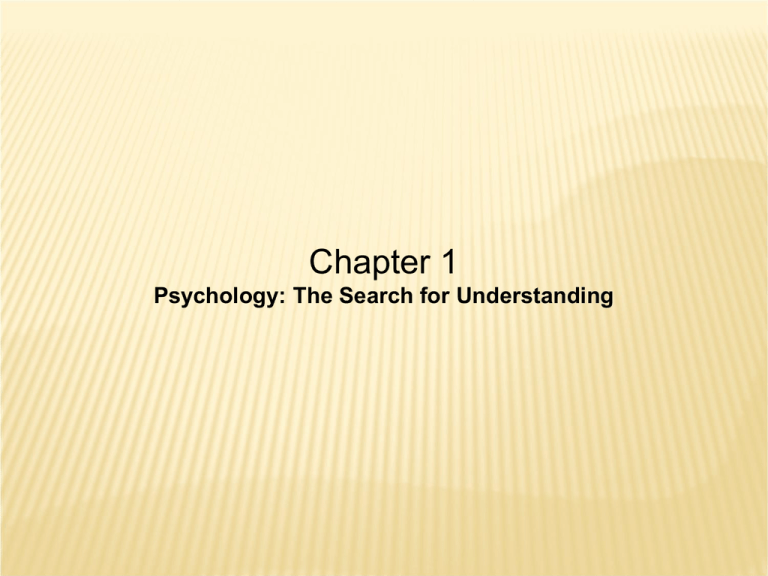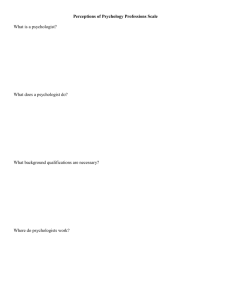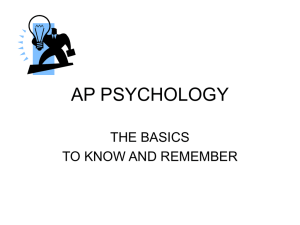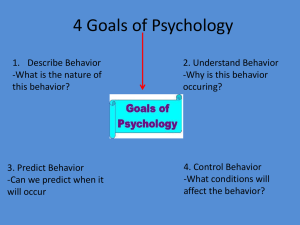Arzy1 '11-12
advertisement

Chapter 1 Psychology: The Search for Understanding What is Psychology? Psychology ◦ ◦ Psyche: Mind Logos: Knowledge or study Definition: The scientific study of behavior and mental processes ◦ ◦ Behavior: Overt i.e. can be directly observed (crying) Mental Processes: Covert i.e. cannot be directly observed (remembering) What are the Goals of Psychology? Description of behaviors: naming and classifying various observable, measurable behaviors Understanding: the causes of behavior(s) Prediction: predicting behavior accurately Control: Altering conditions that influence behaviors. ◦ ◦ Positive use: to control unwanted behaviors e.g. smoking, tantrums. Negative use: To control peoples’ behaviors without their knowledge. CARL ROGER’S HUMANISTIC PERSONALITY THEORY What is me? What is not me? Organism Imposed by others Innate Should not be forced to live “what is not me” Fully Functional Person SEEKING PERFECTION Growth is an innate urge Not just a simple an accidental by product of conflict resolution. Thus positive regard… unconditional approval Lowest to Highest 1------------------------------10 1. 2. 3. 4. WHAT IS PSYCHOLOGY? EXPERIMENT RESULTS WHAT ARE COMMON ELEMENTS TO STATEMENTS? WHAT ARE MISCONCEPTIONS? Define Empiricism Page 3 Figure 1.1 Results of an empirical study. The graph shows that horn honking by frustrated motorists becomes more likely as air temperature increases. This suggests that physical discomfort is associated with interpersonal hostility. Riots and assaults also increase during hot weather. Here we see a steady rise in aggression as temperatures go higher. However, research done by other psychologists has shown that hostile actions that require physical exertion, such as a fist fight, may become less likely at very high temperatures. (Data from Kenrick & MacFarlane, 1986.) INTROSPECTION THE METHODOLOGY OF STRUCTURALISM People do not doubt the truthfulness of their own sensory experiences. Structuralists attempted to discover the “mind” by discovering the “building blocks” of conscious experiences by Reporting “pure” immediate sensory experiences INTROSPECTION EXPERIMENT PAIR UP EXPERIMENTER AND INTROSPECTIONISTS 1. Experimenter should present objects (in bag) to introspectionist briefly (2 seconds) then remove it from sight. 2. Introspectionist should say whatever comes in to mind about qualities of the object. Do not report on emotional experience, but on sensory experience. 3. Experimenter record responses on data sheet. 4. Repeat 3 to 5 times. SIMILARITIES AND DIFFERENCES Answer questions How does this methodology violate empiricism? STOP SIGN BEHAVIOR EXPERIMENT Identify location and date and time of observation. For each car, record the sex of the driver and type of stop Draw conclusions about information that was gathered. History of Psychology (Brief!): Beginnings Wilhelm Wundt: “Father” of Psychology 1879: Set up first lab to study conscious experience Introspection: Looking inward i.e. examining and reporting your thoughts, feelings, etc. Wundt’s ideas brought to the USA by Tichener and renamed Structuralism Structuralists disagreed and no way to prove who was correct! William James (American) and Functionalism How the mind functions to adapt to our environment Functionalists admired Darwin and his theory of Natural Selection: Animals keep features through evolution that help them to adapt to environments History of Psychology: Behaviorism and Cognitive Behaviorism Behaviorism: Watson and Skinner Psychology must only study observable behavior objectively Watson studied Little Albert with Rosalie Raynor; Skinner studied animals almost exclusively Cognitive Behaviorism: Ellis and Bandura Our thoughts influence our behaviors. Used often in treatment of depression. History of Psychology: Freud and Gestalt Psychoanalytic: Freud Our behavior is largely influenced by our unconscious wishes, thoughts and desires, especially sex and aggression. Freud performed dream analysis and was an interactionist (combination of our biology and environment make us who we are). Recent research has hypothesized that our unconscious mind is partially responsible for our behaviors. Gestalt: Studies whole, not parts. Key Names: Wertheimer, Perls Figure 1.2 The design you see here is entirely made up of the two elements shown below it. If you stare at the design for a moment, you should quickly see that as a whole it contains patterns and complexities that greatly exceed the sum of its parts. History of Psychology: Neo-Freudians Neo-Freudians: Jung, Adler, Horney Jung: Unconscious is a combination of our personal and ancestors’ experiences Adler: Inferiority and superiority complexes; our birth order with respect to siblings helps to determine our personalities Horney: Women are not biologically inferior but are pushed into believing they’re inferior by society. Neurotic needs and tyranny of shoulds History of Psychology: Humanism Humanism: Rogers and Maslow Goal of psychology is to study unique aspects of the person. Each person has innate goodness and is able to make free choices (Contrast with Skinner and Freud). Psychology Today Biopsychology: Our behavior can be explained through physiological processes Uses brain scans to gather data (CT, MRI, PET) Looks at neurotransmitters Treats psychological problems with medications. Cultural Awareness Many thoughts and behaviors influenced by our culture Psychologists need to be aware of impact cultural diversity may have on our behaviors. What is acceptable in one culture might be unacceptable in another. Many Flavors of Psychologists Psychiatrist: MD; usually uses medications to treat problems. Generally does not have extensive training in providing “talk” therapy. Psychoanalysts: Receive additional training post-Ph.D. at an institute Psychiatric Social Workers: Many have masters degrees and perform psychotherapy. Presently very popular profession Not all psychologists perform therapy! Figure 1.3 (a) Specialties in psychology. Percentages are approximate. (b) Where psychologists work. (c) This chart shows the main activities psychologists do at work. Any particular psychologist might do several of these activities during a work week (APA, 1998). The percentages shown here are based on membership in the American Psychological Association (APA). The APA welcomes both scientists and practitioners. However, some psychological researchers belong to other organizations, such as the American Psychological Society. As a result, the percentage of clinical and counseling psychologists working in the United States may be a little lower than shown in chart a. Nevertheless, it is accurate to say that most psychologists specialize in applied areas and work in applied settings. American Psychological Association Largest professional organization for psychologists Student membership available and advisable Annual convention draws 10-20,000 people Critical Thinking Ability to analyze, evaluate and synthesize information. What would you expect to see if the claim is true? Gather evidence relevant to the claim Evaluate the evidence Draw a conclusion Oftentimes used in research Pseudo-Psychologies Pseudo means “false.” Any unfounded “system” that resembles psychology and is NOT based on scientific testing Palmistry: Lines on your hands (palms) predict future and reveal personality. Phrenology: Personality traits revealed by shape of skull and bumps on your head. Pseudo-Psychologies Graphology: Personality revealed by your handwriting Astrology: The positions of the stars and planets at birth determine your personality and affect your behavior. Extremely popular today (“What’s your sign?”). Barnum Effect: Always have a little something for everyone. Make sure all palm readings, horoscopes etc. are so general that something in them will always apply to any one person!







